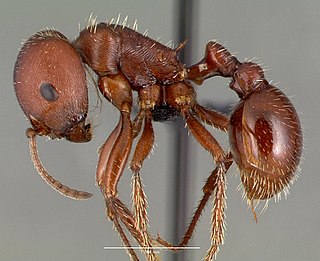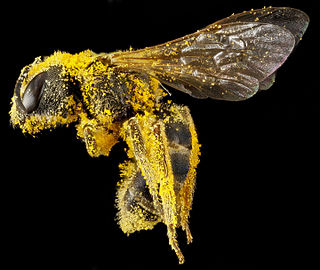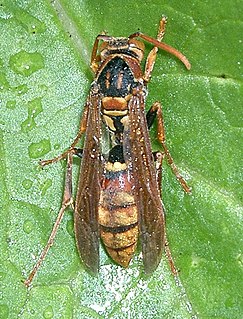Related Research Articles

Pogonomyrmex barbatus is a species of harvester ant from the genus Pogonomyrmex. Its common names include red ant and red harvester ant. These large ants prefer arid chaparral habitats and are native to the Southwestern United States. Nests are made underground in exposed areas. Their diets consist primarily of seeds, and they consequently participate in myrmecochory, an ant-plant interaction through which the ants gain nutrients and the plants benefit through seed dispersal. Red harvester ants are often mistaken for fire ants, but are not closely related to any fire ant species, native or introduced.

A decentralised system in systems theory is a system in which lower level components operate on local information to accomplish global goals. The global pattern of behaviour is an emergent property of dynamical mechanisms that act upon local components, such as indirect communication, rather than the result of a central ordering influence of a centralised system.

Bombus terrestris, the buff-tailed bumblebee or large earth bumblebee, is one of the most numerous bumblebee species in Europe. It is one of the main species used in greenhouse pollination, and so can be found in many countries and areas where it is not native, such as Tasmania. Moreover, it is a eusocial insect with an overlap of generations, a division of labor, and cooperative brood care. The queen is monandrous which means she mates with only one male. B. terrestris workers learn flower colors and forage efficiently.

The dwarf honey bee, Apis florea, is one of two species of small, wild honey bees of southern and southeastern Asia. It has a much wider distribution than its sister species, Apis andreniformis. First identified in the late 18th century, Apis florea is unique for its morphology, foraging behavior and defensive mechanisms like making a piping noise. Apis florea have open nests and small colonies, which makes them more susceptible to predation than cavity nesters with large numbers of defensive workers. These honey bees are important pollinators and therefore commodified in countries like Cambodia.

Halictus rubicundus, the orange-legged furrow bee, is a species of sweat bee found throughout the Northern Hemisphere. H. rubicundus was introduced into North America from the Old World during one of two main invasions of Halictus subgenera. These invasions likely occurred via the Bering land bridge at times of low sea level during the Pleistocene epoch.

Lasioglossum malachurum, the sharp-collared furrow bee, is a small European halictid bee. This species is obligately eusocial, with queens and workers, though the differences between the castes are not nearly as extreme as in honey bees. Early taxonomists mistakenly assigned the worker females to a different species from the queens. They are small, shiny, mostly black bees with off-white hair bands at the bases of the abdominal segments. L. malachurum is one of the more extensively studied species in the genus Lasioglossum, also known as sweat bees. Researchers have discovered that the eusocial behavior in colonies of L. malachurum varies significantly dependent upon the region of Europe in which each colony is located.

Apis dorsata, the giant honey bee, is a honey bee of South and Southeast Asia, found mainly in forested areas such as the Terai of Nepal. They are typically around 17–20 mm (0.7–0.8 in) long. Nests are mainly built in exposed places far off the ground, like on tree limbs, under cliff overhangs, and sometimes on buildings. These social bees are known for their aggressive defense strategies and vicious behavior when disturbed. Though not domesticating it, indigenous peoples have traditionally used this species as a source of honey and beeswax, a practice known as honey hunting.

The East African lowland honey bee is a subspecies of the western honey bee. It is native to central, southern and eastern Africa, though at the southern extreme it is replaced by the Cape honey bee. This subspecies has been determined to constitute one part of the ancestry of the Africanized bees spreading through North and South America.
Spatial organization can be observed when components of an abiotic or biological group are arranged non-randomly in space. Abiotic patterns, such as the ripple formations in sand dunes or the oscillating wave patterns of the Belousov–Zhabotinsky reaction emerge after thousands of particles interact millions of times. On the other hand, individuals in biological groups may be arranged non-randomly due to selfish behavior, dominance interactions, or cooperative behavior. W. D. Hamilton (1971) proposed that in a non-related "herd" of animals, spatial organization is likely a result of the selfish interests of individuals trying to acquire food or avoid predation. On the other hand, spatial arrangements have also been observed among highly related members of eusocial groups, suggesting that the arrangement of individuals may provide some advantage for the group.

Eusociality, the highest level of organization of sociality, is defined by the following characteristics: cooperative brood care, overlapping generations within a colony of adults, and a division of labor into reproductive and non-reproductive groups. The division of labor creates specialized behavioral groups within an animal society which are sometimes referred to as 'castes'. Eusociality is distinguished from all other social systems because individuals of at least one caste usually lose the ability to perform at least one behavior characteristic of individuals in another caste.

Ropalidia marginata is an Old World species of paper wasp. It is primitively eusocial, not showing the same bias in brood care seen in other social insects with greater asymmetry in relatedness. The species employees a variety of colony founding strategies, sometimes with single founders and sometimes in groups of variable number. The queen does not use physical dominance to control workers; there is evidence of pheromones being used to suppress other female workers from overtaking queenship.

Within the insect order Hymenoptera, the Halictinae are the largest, most diverse, and most recently diverged of the four halictid subfamilies. They comprise over 2400 bee species belonging to the five taxonomic tribes Augochlorini, Thrinchostomini, Caenohalictini, Sphecodini, and Halictini, which some entomologists alternatively organize into the two tribes Augochlorini and Halictini.

Lasioglossum zephyrus is a sweat bee of the family Halictidae, found in the U.S. and Canada. It appears in the literature primarily under the misspelling "zephyrum". It is considered a primitively eusocial bee, although it may be facultatively solitary. The species nests in burrows in the soil.

Formica truncorum is a species of wood ant from the genus Formica. It is distributed across a variety of locations worldwide, including central Europe and Japan. Workers can range from 3.5 to 9.0mm and are uniquely characterized by small hairs covering their entire bodies. Like all other ants, F. truncorum is eusocial and demonstrates many cooperative behaviors that are unique to its order. Colonies are either monogynous, with one queen, or polygynous, with many queens, and these two types of colonies differ in many characteristics.

Halictus ligatus is a species of sweat bee from the family Halictidae, among the species that mine or burrow into the ground to create their nests. H. ligatus, like Lasioglossum zephyrus, is a primitively eusocial bee species, in which aggression is one of the most influential behaviors for establishing hierarchy within the colony, and H. ligatus exhibits both reproductive division of labor and overlapping generations.

Polybia occidentalis, commonly known as camoati, is a swarm-founding advanced eusocial wasp. Swarm-founding means that a swarm of these wasps find a nesting site and build the nest together. This species can be found in Central and South America. P. occidentalis preys on nectar, insects, and carbohydrate sources, while birds and ants prey on and parasitize them. P. occidentalis workers bite each other to communicate the time to start working.

Polistes japonicus is a eusocial paper wasp found in Japan. It was first described by Henri Louis Frédéric de Saussure in 1858. It is closely related to Polistes formosanus. This species lives in small colonies with few workers and a foundress queen. Nests of these wasps are sometimes used as a traditional medicine in Korea, China, and Japan.

Megalopta genalis is a species of the family Halictidae, otherwise known as the sweat bees. The bee is native to Central and South America. Its eyes have anatomical adaptations that make them 27 times more sensitive to light than diurnal bees, giving it the ability to be nocturnal. However, its eyes are not completely different from other diurnal bees, but are still apposition compound eyes. The difference therefore lies purely in adaptations to become nocturnal, increasing the success of foraging and minimizing the danger of doing so from predation. This species has served as a model organism in studies of social behavior and night vision in bees.

Plebeia remota is a species of stingless bee that is in the family Apidae and tribe Meliponini. Bees of the species are normally found in a few states in southern Brazil and their nests can be found in tree cavities. Depending on the region, P. remota may have a different morphology and exhibit different behaviors. The bee's diet consists of nectar and pollen that are collected intensely from a few sources. Researchers have conducted a multitude of studies analyzing the changes that occur in the colony during reproductive diapause and what happens during the provisioning and oviposition process or POP.

Social immunity is any antiparasite defence mounted for the benefit of individuals other than the actor. For parasites, the frequent contact, high population density and low genetic variability makes social groups of organisms a promising target for infection: this has driven the evolution of collective and cooperative anti-parasite mechanisms that both prevent the establishment of and reduce the damage of diseases among group members. Social immune mechanisms range from the prophylactic, such as burying beetles smearing their carcasses with antimicrobials or termites fumigating their nests with naphthalene, to the active defenses seen in the imprisoning of parasitic beetles by honeybees or by the miniature 'hitchhiking' leafcutter ants which travel on larger worker's leaves to fight off parasitoid flies. Whilst many specific social immune mechanisms had been studied in relative isolation, it was not until Sylvia Cremer et al.'s 2007 paper "Social Immunity" that the topic was seriously considered. Empirical and theoretical work in social immunity continues to reveal not only new mechanisms of protection but also implications for understanding of the evolution of group living and polyandry.
References
- 1 2 Deborah M. Gordon (1996). "The organization of work in social insect colonies" (PDF). Nature . 380 (6570): 121–124. Bibcode:1996Natur.380..121G. doi:10.1038/380121a0. S2CID 620025. Archived from the original (PDF) on 2011-07-29.
- 1 2 Francis L. W. Ratnieks & Carl Anderson (1999). "Task partitioning in insect societies". Insectes Sociaux . 47 (2): 95–108. doi:10.1007/s000400050119. S2CID 24435668.
- ↑ Arathi, H. S.; Burns, I.; Spivak, M. (2000). "Ethology of hygienic behaviour in the honey bee Apis mellifera L-(Hymenoptera : Apidae): Behavioural repertoire of hygienic bees". Ethology. 106 (4): 365–379. doi:10.1046/j.1439-0310.2000.00556.x.
- ↑ Arathi, H. S.; Spivak, M. (2001). "Influence of colony genotypic composition on the performance of hygienic behaviour in the honeybee, Apis mellifera L". Animal Behaviour. 62: 57–66. doi:10.1006/anbe.2000.1731. S2CID 15913258.
- ↑ John R. Krebs & Nicholas B. Davies (1987). An Introduction to Behavioural Ecology (2nd ed.). Blackwell Scientific Publications. p. 291.
- ↑ Ross H. Crozier & Pekka Pamilo (1996). "Introduction". Evolution of Social Insect Colonies. Sex Allocation and Kin Selection. Oxford Series in Ecology and Evolution. Oxford University Press. pp. 4–8. ISBN 978-0-19-854942-0.
- 1 2 Duarte, A.; Pen, I.; Keller, L.; Weissing, F. J. (2012). "Evolution of self-organized division of labor in a response threshold model". Behavioral Ecology and Sociobiology. 66 (6): 947–957. doi:10.1007/s00265-012-1343-2. PMC 3353103 . PMID 22661824.
- ↑ Wakano, J. Y.; Nakata, K.; Yamamura, N. (1998). "Dynamic model of optimal age polyethism in social insects under stable and fluctuating environments". Journal of Theoretical Biology. 193 (1): 153–165. Bibcode:1998JThBi.193..153W. doi:10.1006/jtbi.1998.0697.
- ↑ Carl Anderson & Daniel W. McShea (2001). "Individual versus social complexity, with particular reference to ant colonies". Biological Reviews . 76 (2): 211–237. doi:10.1017/S1464793101005656. PMID 11396847. S2CID 17673219.
- ↑ Sasha R. X. Dall, Luc-Alain Giraldeau, Ola Olsson, John M. McNamara & David W. Stephens (2005). "Information and its use by animals in evolutionary ecology" (PDF). Trends in Ecology & Evolution . 20 (4): 187–193. doi:10.1016/j.tree.2005.01.010. PMID 16701367.CS1 maint: multiple names: authors list (link)
- ↑ Aaron E. Hirsh & Deborah M. Gordon (2001). "Distributed problem solving in social insects". Annals of Mathematics and Artificial Intelligence . 31 (1–4): 199–221. doi:10.1023/A:1016651613285. S2CID 18283535.
- ↑ Couvillon, MJ; Jandt JM; Duong NHI; A Dornhaus (2010). "Ontogeny of worker body size distribution in bumble bee (Bombus impatiens) colonies". Ecological Entomology. 35 (4): 424–435. doi:10.1111/j.1365-2311.2010.01198.x. PMC 4444232 . PMID 26023250.
- ↑ Rissing, Steven W (1984). "Replete Caste Production and Allometry of Workers in the Honey Ant, Myrmecocystus mexicanus Wesmael (Hymenoptera: Formicidae)". Journal of the Kansas Entomological Society. 57 (2): 347–350.
- ↑ Thomas D. Seeley (1982). "Adaptive significance of the age polyethism schedule in honeybee colonies". Behavioral Ecology and Sociobiology . 11 (4): 287–293. doi:10.1007/BF00299306. JSTOR 4599548. S2CID 37953822.
- ↑ Dhruba Naug & Raghavendra Gadagkar (1998). "The role of age in temporal polyethism in a primitively eusocial wasp" (PDF). Behavioral Ecology and Sociobiology . 42 (1): 37–47. doi:10.1007/s002650050409. JSTOR 4601416. S2CID 14615486.
- ↑ Bert Hölldobler & E. O. Wilson (1990). The Ants. Cambridge, MA: Harvard University Press. ISBN 978-0-674-04075-5.
- 1 2 Muscedere, ML; Willey TA; Traniello JFA (2009). "Age and task efficiency in the ant Pheidole dentata: young minor workers are not specialist nurses". Animal Behaviour. 77 (4): 911–918. doi:10.1016/j.anbehav.2008.12.018. S2CID 53161750.
- ↑ Herb, BR; Wolschin F; Hansen K; Aryee MJ; Langmead B; Irizarry R; Amdam GV; AP Feinbert (2012). "Reversible switching between epigenetic states in honeybee behavioral subcastes". Nature Neuroscience. 15 (10): 1371–1375. doi:10.1038/nn.3218. PMC 3518384 . PMID 22983211.
- ↑ Kuszewska, K; Woyciechowski M (2012). "Reversion in honeybee, Apis mellifera, workers with different life expectancies". Animal Behaviour. 85: 247–253. doi:10.1016/j.anbehav.2012.10.033. S2CID 54346742.
- ↑ Thenius, R.; Schmickl, T.; Crailsheim, K. (2008). "Optimisation of a honeybee-colony's energetics via social learning based on queuing delays". Connection Science. 20 (2–3): 193–210. Bibcode:2008ConSc..20..193T. doi:10.1080/09540090802091982. S2CID 27954392.
- ↑ Tarapore, D.; Floreano, D.; Keller, L. (2010). "Task-dependent influence of genetic architecture and mating frequency on division of labour in social insect societies". Behavioral Ecology and Sociobiology. 64 (4): 675–684. doi:10.1007/s00265-009-0885-4. S2CID 6084107.
- 1 2 3 Jennifer H. Fewell (2003-09-26). "Social Insect Networks". Science . Retrieved 2013-11-26.
- ↑ "The effect of individual variation on the structure and function of interaction networks in harvester ants". 171.66.127.193. 2011-11-07. Retrieved 2013-11-26.
- 1 2 Blonder, B; Dornhaus, A (2011-05-20). "Time-Ordered Networks Reveal Limitations to Information Flow in Ant Colonies". PLOS ONE. 6 (5): e20298. Bibcode:2011PLoSO...620298B. doi: 10.1371/journal.pone.0020298 . PMC 3098866 . PMID 21625450.
- ↑ Buffin, Aurélie; Goldman, Serge; Deneubourg, Jean Louis (2012-07-01). "Collective regulatory stock management and spatiotemporal dynamics of the food flow in ants". The FASEB Journal . 26 (7): 2725–2733. doi:10.1096/fj.11-193698. PMID 22456340. S2CID 20443551 . Retrieved 2013-11-26.
- ↑ Latty, Tanya; Ramsch, Kai; Ito, Kentaro; Nakagaki, Toshiyuki; Sumpter, David J. T.; Middendorf, Martin; Beekman, Madeleine (2011-09-07). "Structure and formation of ant transportation networks". Journal of the Royal Society Interface . 8 (62): 1298–1306. doi:10.1098/rsif.2010.0612. PMC 3140716 . PMID 21288958 . Retrieved 2013-11-26.
- ↑ Jeanson, R (2012). "Long-term dynamics in proximity networks in ants". Animal Behaviour . 83 (4): 915–923. doi:10.1016/j.anbehav.2012.01.009. S2CID 53194591.
- ↑ Michael Goodrich & Roberto Tamassia (2002). Algorithm Design. Wiley. p. 296. ISBN 978-0-471-38365-9.
- ↑ Jennifer H. Fewell (2003). "Social insect networks". Science . 301 (5461): 1867–1870. Bibcode:2003Sci...301.1867F. doi:10.1126/science.1088945. PMID 14512616. S2CID 42373620.
- 1 2 3 4 S. O'Donnell & S. J. Bulova (2007). "Worker connectivity: a review of the design of worker communication systems and their effects on task performance in insect societies". Insectes Sociaux . 54 (3): 203–210. doi:10.1007/s00040-007-0945-6. S2CID 10839817.
- ↑ Carl Anderson, Nigel R. Franks & Daniel W. McShea (2001). "The complexity and hierarchical structure of tasks in insect societies". Animal Behaviour . 62 (4): 643–651. doi:10.1006/anbe.2001.1795. S2CID 7551221.
- ↑ Stephen P. Ellner & John Guckenheimer (2006). "Building dynamic models". Dynamic Models in Biology. Princeton University Press. pp. 289–290. ISBN 978-0-691-12589-3.
- ↑ R. Gorelick & S. M. Bertram (2007). "Quantifying division of labor: borrowing tools from sociology, sociobiology, information theory, landscape ecology, and biogeography". Insectes Sociaux . 54 (2): 105–112. doi:10.1007/s00040-007-0923-z. S2CID 40600248.
